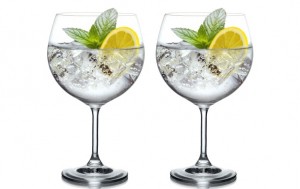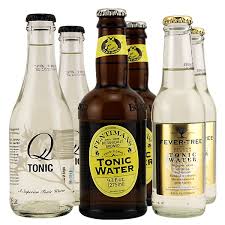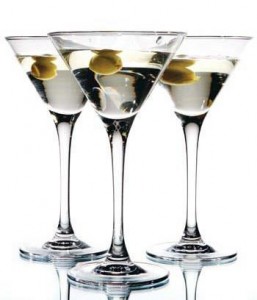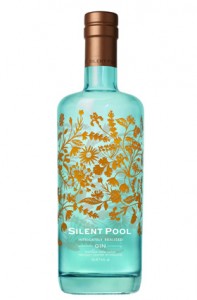“Red meat and gin.” – Julia Child, on the ingredients for a long life.
 Ten years ago micro-breweries hit the market with ‘craft’ or ‘boutique’ beers, providing the world with interesting alternatives to the mass-produced European style lagers. Today, word on the street is that gin is now having a similar renaissance in ‘boutique’ distilleries. Visiting England recently, I discovered a myriad small gin distilleries have been springing up all over the country. And it is not limited to the UK – the resurgence of the juniper berry has struck a chord all over the world. I even met a bloke recently who is planning to make gin at that altar of winemaking, the Barossa Valley. So move over craft beer, designer gin is here.
Ten years ago micro-breweries hit the market with ‘craft’ or ‘boutique’ beers, providing the world with interesting alternatives to the mass-produced European style lagers. Today, word on the street is that gin is now having a similar renaissance in ‘boutique’ distilleries. Visiting England recently, I discovered a myriad small gin distilleries have been springing up all over the country. And it is not limited to the UK – the resurgence of the juniper berry has struck a chord all over the world. I even met a bloke recently who is planning to make gin at that altar of winemaking, the Barossa Valley. So move over craft beer, designer gin is here.
Two years ago, a friend I was visiting in Kent eagerly handed me a gin and tonic. The tonic? Probably Scwheppes. The gin? He was reluctant to share the secret, but eventually told me that it came from the lovely Suffolk seaside town of Southwold. Adnams, originally established as a brewery in 1872, decided to diversify, and in 2010 a distillery was born. Adnams now makes not only beer, but gin, vodka and whisky as well.
This new gin was quite different from the usual gins I drink: the Gilbeys-and-Gordons, Beefeater-and-Bombay Sapphire brigade which have little to recommend them beyond alcoholic content and a neat and unobtrusive match with tonic and lime. Adnans – and the many more boutique gins attempting to upstage the old stalwarts – tastes quite different: more complex, more sophisticated, even poetic flavours that make it distinctive, unusual, unexpected and aromatic.
 Last Christmas my daughter took me along to ‘The Howling Owl,’ a quaint little bar in Adelaide with a not-so-secret stash of boutique gins – more than forty different brands in fact, from all over the world. A tasting tray provided four shot glasses and a selection of garnishes: slices of lemon and lime and cucumber were no surprise, but the sprigs of rosemary, dried juniper berries and peppercorns were a whole new experience. It was great fun – a little like creating a mini cocktail. And the results were fascinating, quite upstaging those old stalwarts above the bar. It was a real eye opener. There were even, it turns out, some new, lighter ‘artisan’ tonics on the market, like Fever Tree and Fentimans.
Last Christmas my daughter took me along to ‘The Howling Owl,’ a quaint little bar in Adelaide with a not-so-secret stash of boutique gins – more than forty different brands in fact, from all over the world. A tasting tray provided four shot glasses and a selection of garnishes: slices of lemon and lime and cucumber were no surprise, but the sprigs of rosemary, dried juniper berries and peppercorns were a whole new experience. It was great fun – a little like creating a mini cocktail. And the results were fascinating, quite upstaging those old stalwarts above the bar. It was a real eye opener. There were even, it turns out, some new, lighter ‘artisan’ tonics on the market, like Fever Tree and Fentimans.
Simply put, gin is flavoured vodka. The base spirit for both spirits is derived from grain, (rye, corn or wheat) or potato and in the case of gin, sometimes even grapes. The base spirit is then infused with juniper berries. Called berries, these are actually berry-shaped seed cones, and give gin a flavour that is often described as ‘piney’ or ‘tasting like Christmas.’ Other ‘aromatics’ or ‘botanicals’ add complexity. These botanicals may include such things as cassia and chamomile, coriander and cardomom, cinnamon, citrus and cubeb berries (Indonesian pepper) – which sounds like the recipe for a magic spell. Typically, a fine gin contains six to ten botanicals.
Gin first appeared in Holland in the seventeenth century. Like many spirits and liqueurs, it was created by the monks, who used it to treat any number of ailments from gout to gallstones, and even the Plague. Its name comes from the Dutch word for juniper – genever – and it became popular with Dutch and British soldiers fighting together during the Thirty Years War (1618-48), where it was praised for its moral boosting and warming effects in the damp and chilly Lowlands of Europe, and nicknamed “Dutch Courage.”
Its popularity – and the recipe – spread from the battlefields to England. Unlicensed production meant anyone could set up a gin still very cheaply, and British gin was a rough-and-ready concoction, fit only for the poor, who drank it liberally, often by the pint, and just as often enhanced with turpentine – highly toxic when ingested. Hardly surprisingly, this led to horrific displays of disorderly drunkenness, ill-health, and death. Gin was even blamed for a negative population growth in London.
Over the next century, the “Gin Craze” grew. Eventually, however, its adverse effects on society caused panic amongst the elite, and the British Parliament introduced a series of laws and taxes to curb gin consumption by raising prices beyond the reach of the poor. This lead, predictably perhaps, to street riots and a flood of illegal gin stills, and the laws were repealed, and eventually replaced by more reasonable ones.
As these milder reforms gradually took effect, gin production became more refined, and gin gradually climbed out of the gutter. In the nineteenth century, the ‘column still’ was invented, which allowed gin distillers to improve the quality of the base spirit. They also started to play around with different flavours. London dry gin was born; a specific style of gin, not necessarily made in London, but involving a double distillation of the grain to which the botanicals are added only during the second distillation. The upper classes were entranced. Ornate and luxurious gin palaces were established to provide sophisticated settings for this now sophisticated panacea.
Tonic water was first introduced to gin in Colonial India in the nineteenth century. Gin and soda was already a popular drink amongst the British military stationed there, quinine a necessary evil in a malaria-ridden country. And then some clever chap devised a cocktail of carbonated water, gin and quinine that made the latter so much more palatable. As Winston Churchill is quoted as saying: “the gin and tonic has saved more Englishmen’s lives and minds than all the doctors in the Empire.”
Then, in the twentieth century, gin became a popular base for flamboyant cocktails, but I am not going to dwell on that here.
Instead, let’s leave history for now and drop into a small High Street wine shop in Surrey, where Alistair, my guide to the New World of Gin is waiting to introduce me to a selection of English craft gins. Arranged on an old wine barrel at the back of the store are at least a dozen bottles of gin, a carafe of water and two sherry glasses.
Some tips, though, before we start:
- Although reminiscent of a wine tasting, we are only using a small sherry glass (a shot glass will do, too). Gin is a spirit and therefore much stronger than wine, and you may need to get home afterwards.
- There is no tonic in sight – we will taste the gin straight and possibly with a splash of water, which apparently releases the botanical flavours.
- It is best served at room temperature (approximately 15°C).
- Swish it gently around your mouth, like wine, and note the effects.
- “Generally speaking, a nice aroma and a smoothness of taste are good starters. If it tastes thin and has a burn to it, avoid it.” ~ Tanqueray’s master distiller Tom Nichol.
- Explore the flavours. All gins contain juniper, but each gin will have its own unique combination of botanicals.
So explore we do, my guide happily joining me to compare aromas and flavours. Initially, I bow to his superior knowledge, but surprisingly quickly I find myself interjecting with my own discoveries.
Silent Pool is an English gin named for a spring-fed lake at the foot of the North Downs, near Guildford. This  delicate but complex gin is captured in a beautiful turquoise glass bottle and claims to contain some twenty-four ‘unique’ botanicals. Cory Mason, the Head Distiller at Silent Pool, describes their signature product as “full-bodied and fresh, with depth, clarity, and above all else flavour.“ His flavour descriptors include “clean juniper-driven spirit with floral layers of lavender and chamomile. Fresh notes of citrus and kafir lime… [and] local honey.”
delicate but complex gin is captured in a beautiful turquoise glass bottle and claims to contain some twenty-four ‘unique’ botanicals. Cory Mason, the Head Distiller at Silent Pool, describes their signature product as “full-bodied and fresh, with depth, clarity, and above all else flavour.“ His flavour descriptors include “clean juniper-driven spirit with floral layers of lavender and chamomile. Fresh notes of citrus and kafir lime… [and] local honey.”
An online reviewer attempted to identify all 24 botanicals, and his check list included “juniper, [obviously] coriander, cassia, chamomile, orris, kaffir lime, elderflower, pear, star anise, coriander, lavender, bergamot, honey, linden, hawthorn, angelica, possibly rosehip,” which sounds like a cross between potpourri and an Indian curry. Rest assured this is not what it tastes like. (And I should know, I have tested two bottles already.)
Beckett’s is another new English gin. Produced in Kingston-upon-Thames, it is made from Box Hill juniper berries – the only British gin, apparently, to use berries grown in the UK. Box Hill is maintained by the National Trust, that blessed English charity that looks after some of Britain’s most beautiful coastline, countryside and heritage houses. Beckett’s management work with the Trust to pick “a strictly controlled number” of berries, at the same time cultivating new juniper plants on Juniper Top where, ironically, they no longer grew. Beckett’s is surprisingly delicate and smooth. Alistair advises me not to drown it in tonic because the flavours are so subtle, and suggests soda water instead, with perhaps a sprinkle of mint and citrus rind. Given that I don’t have malaria, why not?
We also sip a Dorset gin, Conker, which, like Beckett’s, was only born two years ago. (Note that gin can be produced much faster than whiskey, without all that barrel time.) Labelled as another ‘unique’ gin, Conker is created in the back streets of Bournemouth and contains ten ‘select’ botanicals. The producers use Macedonian juniper berries, to which they add local elderberries, samphire and ‘handpicked New Forest gorse flowers’. (How else would one pick gorse flowers, I wonder?) The website claims that Conker is ‘brazenly refreshing and deftly smooth… crafted to stand up on its own, poured and adored over ice.’ (I am really enjoying all these gins, but finding the marketing spiels harder to swallow.)
 Next we travel from the New Forest to the Black Forest in Germany. Monkey 47 is incredibly complex, its name referring to both the number of botanicals used and the fact it’s bottled at a healthy 47%. ‘Good on your cornflakes,’ jokes Alistair. Ha! It just about knocks my socks off to drink neat. I would highly recommend at least a dash of soda and maybe a curl of lime zest. If you have ever tasted that other monk-made drink Benedictine, it has similar overtones of the floral and the heartily medicinal. It even looks like an old-fashioned medicine bottle.
Next we travel from the New Forest to the Black Forest in Germany. Monkey 47 is incredibly complex, its name referring to both the number of botanicals used and the fact it’s bottled at a healthy 47%. ‘Good on your cornflakes,’ jokes Alistair. Ha! It just about knocks my socks off to drink neat. I would highly recommend at least a dash of soda and maybe a curl of lime zest. If you have ever tasted that other monk-made drink Benedictine, it has similar overtones of the floral and the heartily medicinal. It even looks like an old-fashioned medicine bottle.
I guess the next gin to be Slavic, partly from the name (Makar is a Russian boy’s name), partly from its potency. But Makar also means ‘poet’ in Scotland, and the gin proves to be a robust little Glaswegian number: hot, musky and high octane. Think Turkish Delight infused with pepper. Makar contains ‘seven internationally sourced botanicals,’ including rosemary and black pepper. This one too arrived on the scene in 2014 – obviously an excellent year for the rebirth of gin – from a new distillery built in the heart of Glasgow.
So go forth and drink gin – there are plenty more to choose from. I have even tried a pink one flavoured with rhubarb! (Way too sweet for me, though.) And it turns out I am in the right place to share the news: figures say that there is more gin drunk in the Philippines than anywhere else in the world; that the annual global sale of gin is nearly 60 million cases, and almost half of this is consumed in the Philippines. So it looks like I am in good company. In the meantime, though, before I join you at the bar, I am off to find a dose of Mother’s Milk to cure my cold, or maybe I will make one of those gin and tonic popsicles I saw on Facebook this week…
*with thanks to Google Images for the pics.

